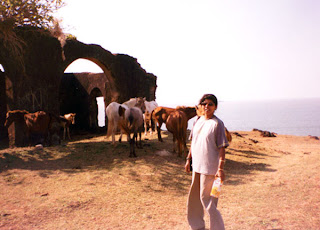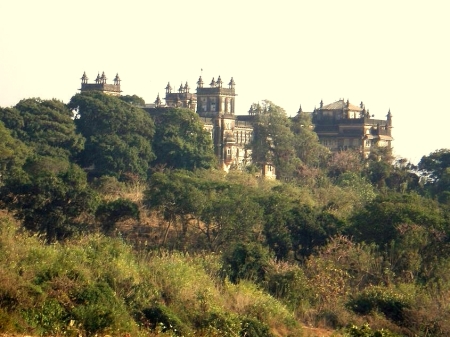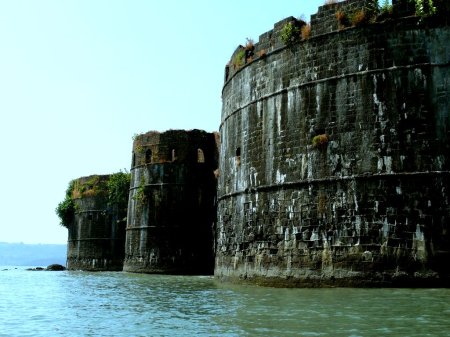I have been regularly travelling length and breadth of coorg intensively during 1989 to 1991. Of course it was on official mission, discharging my duties as sales executive, ensuring width and depth of distribution of biscuits among the retailers. The landscape of coorg was dotted with coffee plantation, cardamon, aeracanut, pepper and many other natures offerings I used to look forward for once in two months visit to this territory due to cool climate and their unique food offerings in the form of pork curry and puddings. Sometimes we used to visit the buddhist camp in Bailkuppa where we used to thrive on momos and their noodles. Never i had an opportunity to witness a coorgi marriage, and when the opportunity presented itself on a golden platter through my ex colleague, i jumped into the fray and accepted his invite gleefully.
Just imagine having a holiday in coorg and getting to attend a traditional coorgi wedding, nothing can get better than this. I was hardly aware of the rich traditions of coorgis particularly their wedding. My colleagues co-brothers marriage was fixed and he requested me to attend the wedding last May, and the weather turned from a summer to monsoon weather overnight. It was as if the heavens too were in a mood to bless the newly married couple.
Generally the wedding is preceded by a common reception for the friends and relatives of the bridegroom and bride prior to the marriage ceremony. It is generally a cocktail party with plenty of non vegetarian snacks and bites. During this get together the menfolk and women dance in the traditional coorgi style, which is almost close to garba dance. Children too join the fray and dance to beats played on sound system. Some of the drunken members are controlled by the elders or friends so that they do not spoil the party for everyone. I just happened to see an youngster going out of control and requested his friends to take him back to his residence so that he does not puke out.
.




Just imagine having a holiday in coorg and getting to attend a traditional coorgi wedding, nothing can get better than this. I was hardly aware of the rich traditions of coorgis particularly their wedding. My colleagues co-brothers marriage was fixed and he requested me to attend the wedding last May, and the weather turned from a summer to monsoon weather overnight. It was as if the heavens too were in a mood to bless the newly married couple.
Generally the wedding is preceded by a common reception for the friends and relatives of the bridegroom and bride prior to the marriage ceremony. It is generally a cocktail party with plenty of non vegetarian snacks and bites. During this get together the menfolk and women dance in the traditional coorgi style, which is almost close to garba dance. Children too join the fray and dance to beats played on sound system. Some of the drunken members are controlled by the elders or friends so that they do not spoil the party for everyone. I just happened to see an youngster going out of control and requested his friends to take him back to his residence so that he does not puke out.
.

The system of dowry is absent among coorgis, marriage expenses are equally shared between the boys and girls family. Except that the girls family might deck their daughter with jewelleries according to their status. Traditional attire is worn by men and women. The men wear a black robe with a turban decked with a warrior type of sword or khukri. The women wear traditional silk saree with plenty of jewellery.
I landed just on the dot, at around 8.25pm,from Bangalore to Madikere, when some of the guests started their dinner, without drinks since they had to rush home. I had to freshen up, took up a lodge right opp the wedding hall and had a good bath to refreshing weather, which started drizzling. Next i straight away went and filled up glass with Blenders pride and went on to enjoy the cocktails with pork meat, chicken kabbabs and many other bites to savour.

CAUTION :
Most of the Coorgis are allowed to carry guns without license, the only district in India probably enjoys this privilege, outsiders beware. Never get into trouble because you may never live to tell your side of the story.
Once the engagement is fixed
the girls family is free to call of the marriage if they have second thoughts, than they have to face the music of the community if they are not justified in their decision.
Most of the Coorgis are allowed to carry guns without license, the only district in India probably enjoys this privilege, outsiders beware. Never get into trouble because you may never live to tell your side of the story.
Once the engagement is fixed
the girls family is free to call of the marriage if they have second thoughts, than they have to face the music of the community if they are not justified in their decision.
Most of the close relatives are dressed in tradition warrior suits, which consists of dagger. The dagger comes in various shapes, khukri type, mostly chistled in silver. The women folk dress in sari which is uniquely draped on them. The youngsters fall at the feet of their elders seeking blessings galore.
Next day the ceremony begins with breakfast and than the cutting of banana plant trunk with a help of a sword. Most of the male members participate along with women folk. This ceremony is carried out by the elders, with no specialised priest called for the occasion. Later during the marriage ceremony a bidding sort of arguement takes place which is fun to watch. The marriage ceremony by itself is very simple and quick.
During the reception a cake is cut and distributed among the relatives. The reception is attended by select few who are close to the bride and grooms family. The crowd is comparatively limited.

Breakfast, is served with plenty of sweat meats, lunch is served with plenty of non veg, a mix of mutton, chicken and pork along with fish kumra is served in buffet fashion. Just imagine the lavish affair can cost as much as 3 lakhs for a wedding. Further booze and hall etc would account for another lakh. In all a decent coorgi marriage would mean a minimum expense of 4 lakhs, 2 lakhs each.
The estimation of number of guests may go haywire, coorgis invariably tend to order for more guest, in our case it was for 1800 but only 1300 turned up, due to inclement weather.

The best part of the traditional is revealed in the end with a custom of the bride carrying the ganga water towards the mantap, she is prevented by the boys family dancing in front. So she has to take a slow and caliberated step making sure that she does not spill the water from the container. It is a slow trudge towards the mantap, it can take from 3 hours to 10 hours depending on the boys family. Here our bride had to endure the ceremony for 3 and half hour. Later the ceremony ended with plenty of cocktails and dinner, along with cake cutting ceremony. I enjoyed my Bacardi with passion fruit cocktail. Long live coorgi tradition. Do not miss a chance if you are invited for a coorgi wedding, even if you are a vegetarian, you won t be disappointed. The custom and tradition is so unique that one is bound see time fly past and the ceremony is etched in our memory.























